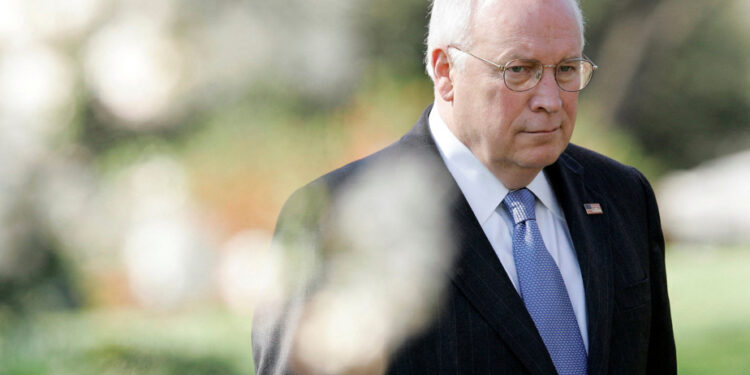(Washington) A man of the shadows, renowned for his considerable influence behind the scenes, the former American vice-president, Dick Cheney, has died at the age of 84, his family announced to the American media on Tuesday.
His death, which occurred on Monday, was due to complications related to pneumonia as well as heart and vascular diseases, according to a statement from his family.
Plagued by coronary problems most of his adult life, Mr. Cheney suffered five heart attacks between 1978 and 2010 and had a device to regulate his heart rate since 2001.
The former number two of George W. Bush (2001-2009) had built such a reputation that he was considered one of the most powerful vice-presidents in American history.
PHOTO JEFF MITCHELL, REUTERS ARCHIVES
Dick Cheney and George W. Bush in July 2000
He surprised Americans during the 2024 presidential election by announcing that he would vote for Democrat Kamala Harris, denouncing his Republican opponent, Donald Trump, whom he considered unfit to occupy the Oval Office.
“We have a duty to place the country above partisan divisions to defend our Constitution,” he declared.
Dick Cheney was George W. Bush’s running mate in two successful presidential campaigns and his most influential adviser at the White House in an era marked by terrorism, war and economic change.
He will remain known as one of the hawks who played a central and controversial role in the 2003 invasion of Iraq.
Entering the White House under Republican President Gerald Ford, Dick Cheney later replaced Donald Rumsfeld as chief of staff and then led, unsuccessfully, Gerald Ford’s re-election campaign against Jimmy Carter in 1976.
An unconditional Republican, Mr. Cheney shortly after launched into the electoral race to win in 1978, in Wyoming, an elected seat in the House of Representatives in Washington which he occupied for a decade.
Appointed Secretary of Defense under George HW Bush in 1989, Dick Cheney was in charge of the Pentagon during the Gulf War of 1990-1991. Then he left for the private sector when Democrat Bill Clinton ousted Bush Sr. from the White House.
PHOTO KEVIN LARKIN, AGENCE FRANCE-PRESSE ARCHIVES
Dick Cheney, then Secretary of Defense, in 1991
Appointed CEO of Halliburton in 1995, he led the large oil services group for five years before returning to politics, as George W. Bush’s running mate for the 2000 presidential election.
Afghanistan and Iraq
Having become vice president, the culmination of his long political rise, Dick Cheney brought his neoconservative ideology to the White House and played a greater role in this position than most of his predecessors.
He is notably considered one of the driving forces behind the decision to invade Afghanistan less than a month after September 11. Seventeen months later, the United States invaded Iraq.
Iraq had no active programs to produce weapons of mass destruction, and postwar analyzes found no operational links between Saddam Hussein’s regime and al-Qaeda.
Saddam Hussein was captured, tried and executed, but the war in Iraq continued until 2011, and U.S. troops remained in the country for another decade, seeking to stabilize the country and repel the extremists of the Islamic State group.
Nearly 5,000 Americans were killed in this war.
The conflict in Afghanistan continued into 2021, when President Joe Biden withdrew the last U.S. troops, ending a war in which more than 2,300 U.S. service members died and allowing the Taliban to regain control of the country.
Dick Cheney later said he refused to believe that Saddam Hussein was not developing a weapons of mass destruction program.
He was also one of the greatest advocates of American enhanced interrogation techniques, now widely considered torture.
The second largest oil services company in the world, Halliburton grew considerably during the Second Iraq War.



